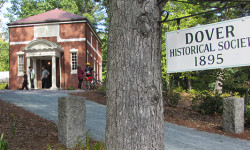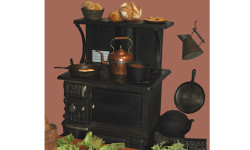By Amelia Tarallo
Hometown Weekly Staff
Those who have visited Dover’s Sawin Museum knows that it has a particularly detailed and professional way of storytelling through exhibits. Downstairs, there’s a setup used to teach kids about life in the 1800s. The middle floor hosts a room of revolving exhibits. It should shock no one that the upstairs is currently the site of the newest and possibly most ambitious exhibit so far, one that endeavors to cover Dover’s “unsung, unglamorous” history from 1850 to 1950.
It is no small challenge, but one that Lori Carbone is keen to tackle.
At the moment, the first thing visitors see upstairs is a scene of organized chaos. Display cases are covered by different artifacts, through which Carbone has been sifting for the last few weeks. Boxes can be spotted in different parts of the room. Parts of former exhibits remain up, not yet ready to be switched out. Carbone is the chief organizer behind this new exhibit. Since starting, she has found boxes filled with different objects all over the museum. “I’ve pulled every single box,” she says. She goes through each one, sorting the different objects to see if they have any place in this new exhibit. “See, this all I found for the police,” says Carbone, showing one group of artifacts. “And this is all I found for the fire department,” she adds, showing a photo of a fire from a school just down the street.
Beside it is a ledger listing different products and their prices. One bushel of potatoes, apples, rice, and ginger, to name just a few. The ledger, used during a time long before spreadsheets and electronic calculators, is believed to have belonged to Marshal Newell. A thinner ledger beside it belonged to Elijah Perry. This one is different, with a list of columns with products and the names of different people beside it: tobacco, raisins, and even boots. With just these clues, Carbone ponders if it was from a store selling these products, or perhaps one of the nearby farms.
From sorting different items to finding a concrete story to tell, the creation of the exhibit is a challenge that Carbone welcomes. “When people walk in here, I want them to get it right away. I want them to feel the spirit of Dover. Digging through the museum storage, I was excited to edit the items into a glorious story of early Dover life,” she says. “However, there is no treasure trove! And I realized that I would have to make due, be creative and innovative. And isn’t that historically the New England way? I think the exhibit will be more accurate and give a richer presentation because of it.”
Carbone is far from putting the finishing touches on her exhibit. She’s still searching everywhere for items connected to iconic Dover places, like Higgins Market, Dover Drug, the Grange and services provided from the town.
Curious residents should keep their eyes out, though, as they’re in store for a treat. When the exhibit is done, visitors will be able to walk upstairs and experience slices from Dover’s “ordinary” past - slices that demonstrate the town’s soul hasn’t changed that much, despite the passage of time.























